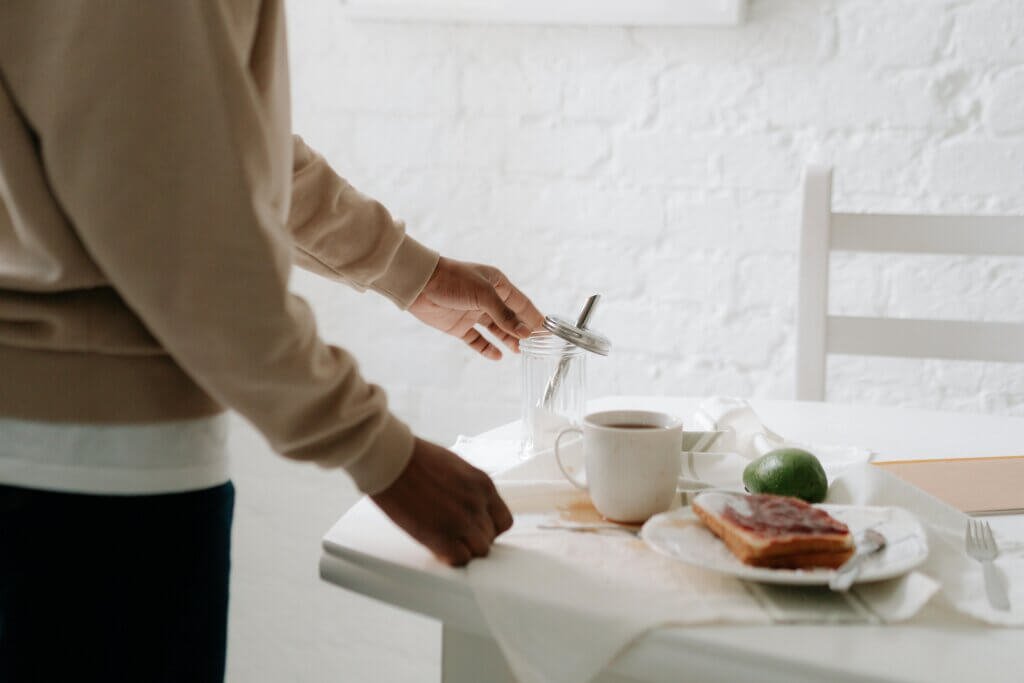Have you ever wondered what goes into creating the perfect cup of coffee that is bursting with unique flavors? Well, look no further because in this article, we will explore the fascinating science behind blending coffee beans to achieve those distinct flavor profiles that make your morning brew a truly delightful experience. From understanding how the roasting process affects the flavors to discovering the art of combining different bean varieties, get ready to dive into the world of coffee blending and uncover the secrets behind your favorite cup of joe.

Understanding Coffee Beans
Coffee beans are the crucial starting point for creating unique flavor profiles in coffee. There are several types of coffee beans, each with its own distinct characteristics and flavor profiles. The main types include Arabica and Robusta beans, with Arabica being the most popular and widely consumed. Arabica beans are known for their delicate and nuanced flavors, while Robusta beans have a more robust and bitter taste. Other varieties of coffee beans include Liberica and Excelsa, although they are less commonly used.
Factors such as the altitude, climate, soil conditions, and cultivation methods greatly affect the flavor of coffee beans. For instance, beans grown at higher altitudes tend to have a more complex and acidic taste, while beans grown in lower altitudes may have a smoother and less acidic profile. Similarly, the soil composition and weather conditions in a particular region can impart unique flavors to the beans.
Different flavor profiles can also be achieved through various processing methods. Coffee beans can be processed using either the dry or wet method. The dry method involves drying the beans in the sun, while the wet method involves removing the outer skin and pulp before drying. Each method imparts different flavors and characteristics to the beans, leading to a wide range of flavor options for coffee enthusiasts.
The Role of Blending in Coffee
Blending is an essential process in the world of coffee, where the aim is to create a harmonious and well-balanced flavor profile. Coffee blending refers to the art of combining different types of coffee beans to achieve a specific taste. By blending different beans, coffee roasters and baristas can fine-tune the flavor, body, acidity, and aroma of the final product.
Blending coffee beans offers several benefits. Firstly, it allows for the creation of unique and complex flavor profiles that might not be achievable with a single origin bean. By blending beans with varying characteristics, such as different levels of acidity, sweetness, and body, roasters can create a well-rounded and balanced cup of coffee.
Blending also provides consistency in taste. Single origin beans can sometimes carry subtle variations in flavor due to factors like climate or processing techniques. By blending beans from different regions, these variations can be minimized, resulting in a more consistent flavor profile. This is particularly important for coffee brands that strive to deliver a reliable and consistent taste experience to their customers.
To achieve the desired flavor profile, roasters employ a range of blending techniques. One common approach is to blend beans with contrasting characteristics, such as combining a high-acidity bean with a low-acidity bean to balance out the overall acidity of the blend. Another technique involves blending beans with complementary flavors to enhance specific notes in the final cup of coffee. By carefully selecting and combining the right beans, roasters can create unique and distinctive flavor profiles.

Science Behind Flavor Development
The flavor of coffee is a result of its complex chemical composition. Coffee beans contain numerous compounds that contribute to its taste, aroma, and body. Understanding the science behind flavor development is crucial for achieving the desired flavor profiles in coffee.
During the roasting process, various chemical reactions occur within the coffee beans. These reactions lead to the formation of flavor compounds, which are responsible for the unique taste and aroma of coffee. One of the key reactions that takes place is known as the Maillard reaction. This reaction occurs when heat is applied to amino acids and reducing sugars present in the beans, resulting in the browning of the beans and the creation of a wide range of flavor compounds.
The level of roasting plays a significant role in flavor development. Lighter roasts tend to retain more of the bean’s origin characteristics, resulting in a brighter and more acidic cup of coffee. On the other hand, darker roasts produce more caramelized flavors and a fuller body.
Roasters carefully consider the ideal level of roasting for each bean to maximize its flavor potential. By experimenting with different roasting profiles, they can enhance specific flavor notes and create a unique taste experience.
Analyzing Flavor Profiles
Tasting and cupping coffee is an essential skill for understanding and analyzing flavor profiles. Cupping involves the systematic evaluation of coffee samples to assess their aroma, taste, and other qualities. This process allows coffee professionals to compare different coffees and identify specific flavor characteristics.
When cupping coffee, professionals pay attention to various flavor notes that can range from fruity and floral to chocolatey and nutty. They also evaluate factors such as acidity, body, and aroma, which contribute to the overall sensory experience of the coffee.
To measure coffee acidity, professionals assess the perceived brightness or sharpness of the coffee. This acidity can range from bright and tangy to smooth and mellow. Additionally, the body of coffee refers to its tactile perception in the mouth, which can range from light and tea-like to full and syrupy. Lastly, the aroma of coffee plays a crucial role in enhancing the overall flavor experience. It can be floral, fruity, spicy, or even earthy, adding another layer of complexity to the coffee.
By honing their tasting and cupping skills, coffee professionals can identify the unique flavor profiles of different beans and blends. This knowledge is invaluable for creating well-balanced and delicious cups of coffee.

Factors to Consider in Blending
When it comes to blending coffee, there are several factors that roasters need to consider. Understanding the origin and characteristics of single origin coffee beans is crucial for selecting the right beans to blend. Each origin has its own unique flavor profile, and these profiles can greatly influence the overall taste of the blend.
Blending ratios also play a vital role in determining the strength and character of the coffee. Roasters experiment with different ratios to achieve the desired flavor profile, balancing the flavors and characteristics of each bean in the blend. By adjusting the ratio of beans with varying acidity, body, and aroma, they can create a blend that is well-rounded and harmonious.
Achieving a balanced flavor profile in a blend requires careful consideration of the different flavor components. Roasters aim to create a well-balanced blend by selecting beans that complement each other in terms of their flavor notes. For example, a blend may consist of beans with fruity and nutty flavor notes, along with some beans that provide body and depth.
Creating Unique Flavor Profiles
Creating unique flavor profiles in coffee involves a combination of art and science. One approach to achieve this is by choosing complementary coffee beans. By selecting beans that have contrasting yet harmonious flavors, roasters can create blends that are complex and intriguing. For example, pairing a bright and acidic Latin American bean with a nutty and chocolatey African bean can result in a well-balanced and flavorful blend.
Experimenting with different roast levels is another way to create unique flavor profiles. By varying the roast level of each bean in the blend, roasters can bring out different flavor characteristics. For instance, a light roast may highlight the delicate floral notes of a bean, while a darker roast can enhance its caramelized sweetness.
Roasters can also incorporate flavoring agents or additives to further customize the flavor of the blend. Flavored coffees have gained popularity in recent years, with options such as vanilla, caramel, or even spices like cinnamon or cardamom. These additions can add complexity and depth to the flavor profile, appealing to a wide range of tastes.

Mastering the Art of Blending
Mastering the art of blending requires a deep understanding of the target audience and their preferences. Different brewing methods can significantly affect the flavor of coffee, so roasters must consider which brewing methods their customers are likely to use. For example, espresso blends often prioritize a rich and full-bodied flavor, while filter coffee blends may focus more on brightness and clarity.
Consistency and quality control are of utmost importance when it comes to blending. Customers expect a consistent taste experience with each cup, so roasters must ensure that every batch of their blend meets the desired flavor profile. Quality control measures, such as cupping and sensory evaluation, are essential to maintain the high standards of the blend.
Understanding the science behind blending is another crucial aspect. By applying scientific methods to flavor development, roasters can make informed decisions about the selection of beans and the blending process. This knowledge helps them achieve precision and consistency in crafting unique flavor profiles.
The Role of Science in Blending
Blending coffee is not just an art; it also involves scientific principles. By understanding the chemical reactions that occur during blending, roasters can better control and manipulate the flavor compounds in coffee.
Applying scientific methods to flavor development allows roasters to analyze the chemical composition of coffee beans and understand how different compounds contribute to the overall taste and aroma. This knowledge helps them make informed decisions about blending ratios and roast levels to achieve the desired flavor profile.
Utilizing technology is another way that science has advanced the blending process. Modern tools and equipment, such as spectrophotometers and gas chromatographs, can accurately measure the chemical composition of coffee and provide valuable data for roasters. These tools enable precise and consistent blending techniques, ensuring that the desired flavor profiles are achieved consistently.

Precision Blending Techniques
To achieve precision in blending, roasters employ various techniques to control the flavor composition of the final product. One approach is blending by weight or volume, where the exact weights or volumes of each component bean are measured. This technique allows for precise control over the flavor profile and ensures consistency in every batch.
Another technique used by roasters is layering flavors through multiple blending stages. This involves blending different portions of the beans separately before combining them into the final blend. By layering flavors, roasters can create complex and nuanced taste experiences, with each component contributing its unique flavor notes to the overall blend.
Utilizing flavor profiling tools is yet another way to achieve precision in blending. These tools help analyze and measure the different flavor components of coffee, allowing roasters to fine-tune the blend to achieve the desired taste. For example, a roaster might use a refractometer to measure the coffee’s strength and adjust the blend accordingly.
Advancements in Coffee Blending
As technology continues to advance, so do the methods and techniques used in coffee blending. Emerging technologies are being developed to extract flavors more efficiently and enhance the overall blending process.
One such advancement is the use of innovative flavor extraction methods. New techniques, such as cold brewing or nitrogen infusion, can extract unique flavors from coffee beans and create entirely new taste experiences. These methods offer exciting possibilities for roasters to experiment with flavor profiles and cater to evolving consumer preferences.
Artificial intelligence (AI) is also making its way into the world of coffee blending. AI algorithms can analyze vast amounts of data and make predictions about flavor profiles based on specific inputs. This technology enables roasters to create customized blends tailored to individual preferences, further pushing the boundaries of flavor development.
In conclusion, the science of blending coffee beans plays a crucial role in creating unique and distinctive flavor profiles. By understanding the various factors that affect coffee flavor, utilizing blending techniques, and incorporating scientific principles, roasters can craft blends that cater to different tastes and preferences. The art and science of blending coffee combine to create a rich and diverse coffee culture, offering coffee enthusiasts a wide range of flavors to explore and enjoy.


